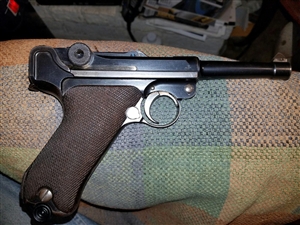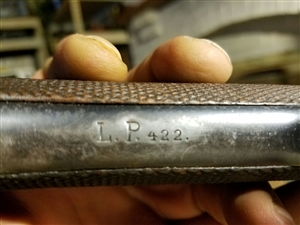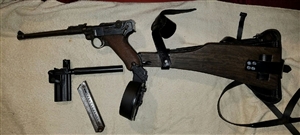Online auctions where you can confiscate guns for cheap
The best way of preventing crime is buying up all the cool guns so the criminals don't buy them. Well it is a theory anyway. I practice this by attending online auctions and bidding competitively.Here is a 1930s civilian air traffic control pistol. Woe to the pilot in Weimar's Germany who improperly filled out his flight plan forms. This specimen is what is called all matching in that every small part has a serial number that matches the serial number of the gun. Often with the passage of several decades some parts get swapped out as they wear out.
Mark of the Air Traffic Control agency (called the air surveillance police in the pre-Hitller Germany).
A 1917 DWM 'Artillery Luger' with it's shoulder stock, the harness, a 32 round snail drum magazine, the snail drum loader device, a more sedate 8 shot magazine and of course the holster. All gun parts matching including the magazine. These pistols were initially marketed so Imperial Army troops assigned to artillery could defend themselves against attackers more efficiently than with a bolt action rifle. Quickly the superiority of these shorter weapons over long bolt action rifles for fighting in the trenches was realized and the 32 round magazine was made. This led, in a 1917 German Infantry manual to the first ever use of the term Assault Weapon. The first German shock troops whose mission was to sneak into enemy trenches at specific pre arranged spots and capture a trench at that specific place were usually armed with these instead of rifles, grenades, daggers and the first flame throwers. The first ever German sub machine gun, the MP-18 also initially used the snail magazines, but stick magazines of less complexity were soon developed. The snail magazine uses both a wound clock work spring and also a more traditional straight coil magazine spring working in tandem.
Many Artillery Lugers were destroyed after the war per the Treaty of Versailles, and of course there was therefore no more use for the snail magazines or the shoulder board stock/holsters.
DWM, Vickers, Switzerland, Stoeger, and a few other firms made about 1.5 million Lugers between 1902 and 1930. Another half million were made from 1930 rhrough 1943 by Mauser and other German firms. After WW2 France confiscated most of the spare parts from Mauser's factory and made another 40,000 or so for their own forces. East Germany, Switzerland and some other countries continued to use their old Lugers into the 1960s before spare parts finally became an issue.
These days even poor condition Lugers with no matching numbers often sell for around $1.000 US. Those in perfect condition or with historical owners often command 6 figures.




Comments (4)